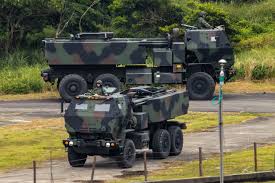
Taiwan Deploys Advanced U.S. Rockets in Key Phase of Annual Military Drills

 :
| Updated On: 12-Jul-2025 @ 1:36 pm
:
| Updated On: 12-Jul-2025 @ 1:36 pmSHARE
Taiwan has initiated the deployment of its latest and most accurate strike weapons—high-calibre U.S.-made rockets—as part of its annual Han Kuang live-fire military exercises aimed at enhancing its defensive capabilities against potential Chinese aggression. These drills come amid growing tensions between China and Taiwan, with the Chinese government considering the self-governed island as its own territory and repeatedly threatening to reunify it with the mainland by force if necessary.
The 10-day Han Kuang exercise, considered Taiwan’s most comprehensive military drill, is designed to simulate realistic war scenarios, including enemy attacks and invasions. According to Reuters, on the fourth day of the drills, two armoured trucks equipped with High Mobility Artillery Rocket Systems (HIMARS) were seen manoeuvring near the city of Taichung, located along Taiwan’s central coast. Military spokesperson Colonel Chen Lian-jia emphasized the importance of concealing the HIMARS systems from enemy surveillance methods such as aerial reconnaissance, satellites, and potential enemy agents within Taiwan, until an official order to launch is given.
The deployment of HIMARS, a powerful rocket artillery system with a strike range of up to 300 kilometers (around 190 miles), signals Taiwan’s strategic focus on enhancing its long-range strike capabilities. These weapons can reach targets along China’s southern coast, including areas in the Fujian province across the Taiwan Strait. Taiwan received the first 11 of the 29 HIMARS units from the United States in 2023 and tested them for the first time in May 2024.
China has responded critically to these developments. Its Ministry of National Defense dismissed the Han Kuang drills as “bluffing and self-deceiving,” while the Ministry of Foreign Affairs reaffirmed China’s strong and consistent opposition to U.S.-Taiwan military cooperation. Beijing views such activities as provocative and a threat to its sovereignty.
In response, Taiwan's President William Lai Ching-te defended the military exercises, stating they are based on “large-scale, realistic combat drills” designed to prepare the country for actual warfare scenarios. These drills, according to unnamed senior Taiwanese military officials quoted by Reuters, are deliberately unscripted to replicate real-time combat environments. They begin with simulated enemy attacks and proceed through various invasion responses to evaluate the readiness of Taiwan’s military forces.
The United States, Taiwan’s principal supplier of defensive arms, is bound by the Taiwan Relations Act to consider threats to Taiwan’s security as a matter of “grave concern.” However, it remains uncertain how the U.S. government, under former President Donald Trump’s administration, would respond in the event of a direct Chinese military assault on Taiwan.
The 2025 Han Kuang drills send a clear message to both China and the international community, particularly the U.S., about Taiwan’s determination to protect its sovereignty. As China increases its military presence around the island through frequent war games and patrols, Taiwan’s defense forces are seeking to match that aggression with improved capabilities and preparation, demonstrating that the island is ready to defend itself under any circumstances.